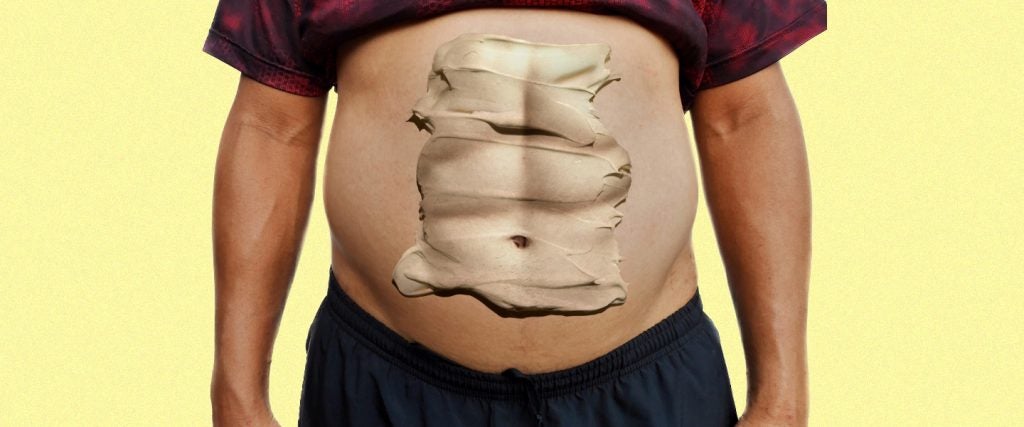If rubbing a cream into your skin was all it took to rid yourself of the undesirable fat dotting the landscape of your stomach, pretty much every health club and plastic surgeon would be out of business. After all, what would you need them for? You now had a magical balm that would make it look as though you were in shape without ever having to move your body any more than you desired.
Such alleged fat-burning creams do exist, but so do health clubs and plastic surgeons. And so, when you see a fat-burning cream on the shelf of the local pharmacy just a few feet away from the IcyHot, what are you actually getting for your money? Can you really apply the cream, take a nap and wake up to a shredded set of six-pack abs?
That would be great. But that’s not how it works, right?
One of the most thorough studies ever published with respect to the benefits of a fat-burning cream is the Lipoxyderm study from 2019. The 10 female subjects were placed on a reduced-calorie diet, asked to formally walk 150 minutes per week as a structured low-intensity workout and rubbed Lipoxyderm onto one of their thighs and a placebo onto the other. Essentially, the women acted as their own control group, and weren’t aware of which cream was rubbed onto each of their thighs.
For the record, caffeine is far and away the predominant active ingredient in Lipoxyderm and most other fat burners, where it’s combined with other thermogenic ingredients to enhance its fat oxidation capabilities, which include smoothing away cellulite, reducing inflammation and tightening skin.
At the conclusion of the 28-day study, the thighs treated with Lipoxyderm lost an average of 1.2 centimeters in circumference, 3.7 millimeters of skinfold thickness and 100 grams of fat mass. This is compared with respective losses of 0.8 centimeters, 1.5 millimeters and 57.3 grams of per-category loss in the placebo group.
So the results were obviously better in the fat-burner category!
It appears that way, but let’s dive in a little deeper.
For starters, it’s fishy that the thighs in the placebo category were an average of 0.6 centimeters smaller in circumference, 0.2 millimeters smaller in skinfold thickness and 15 grams lighter in fat mass than the meatier thighs treated with Lipoxyderm. Basically, it appears as if the areas treated with Lipoxyderm were routinely given the benefit of having more of a natural margin to work with. Therefore, it becomes difficult to identify how much of the differential is owed to Lipoxyderm, and how much is due to the intentional lathering of Lipoxyderm onto the thighs that were likeliest to yield the most impressive results.
Looking at it through that lens, the larger thighs lost 1.8 percent of their overall circumference compared to 1.2 percent of the control group; 8.2 percent of their skinfold thickness compared with 3.4 percent in the control group; and 12.6 percent of their fat mass next to 7.8 percent in the control group. So the actual, demonstrable difference caused by the application of the fat-burning cream is measurable in single-digit percentage points, or in the case of the circumference measurement, less than a single percentage point.
Moreover — and probably more importantly — the average study participant stood 5-foot-4 with an average total body weight of 195 pounds; the corresponding BMI of 33.5 places them well into the obese cateogry at the time the study began. At the conclusion of the study, the average BMI had improved to only 32. That’s because, when you translate the study’s difference in lost body fat into pounds, 100 grams is 0.22 pounds, and 57 grams is 0.12 pounds. In the end then, the subjects had an average total loss of fat mass of 3.8 pounds.
All of that data is worth quoting for the sake of pointing out this one apparent fact: After one month’s worth of physical training, calorie-restrictive dieting and regular use of a fat-burning cream, the average amount of fat poundage lost that appears to be owed to the fat-burning cream alone is 0.1 pounds. That would be 1.2 additional pounds lost if you kept smearing on the cream all year.
But what if I rubbed it all over my body!
I thought you might say that, and this is exactly why we should discuss the fact that your body actually has three different kinds of fat: subcutaneous, visceral and ectopic. Subcutaneous fat sits just beneath the skin (and is pretty much what we’ve been talking about above), while visceral fat is the more pernicious form that surrounds the organs. (Ectopic we’ll discuss another day.) Even if fat-burning creams can play a small role in reducing the amount of subcutaneous fat, their benefits would be limited to the outermost layer of skin. The far more detrimental fat is the visceral fat that contributes to maladies like asthma, liver disease and cancer, and it remains well out of the reach of any creams that can’t effectively penetrate beneath the skin.
All of which is to say the only thing fat-burning creams are smoothing over is the truth.

